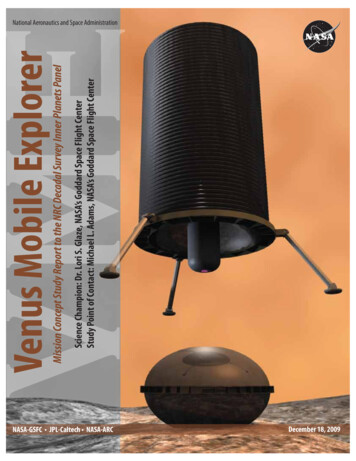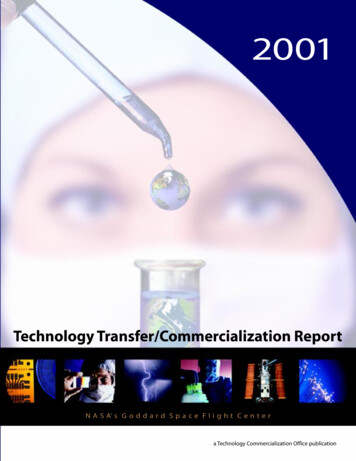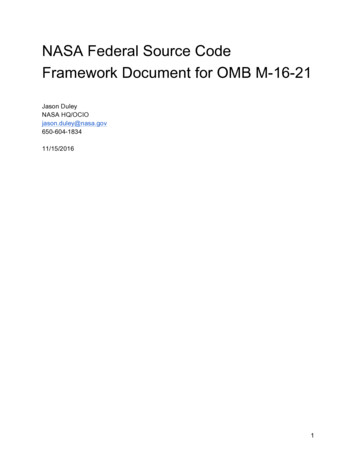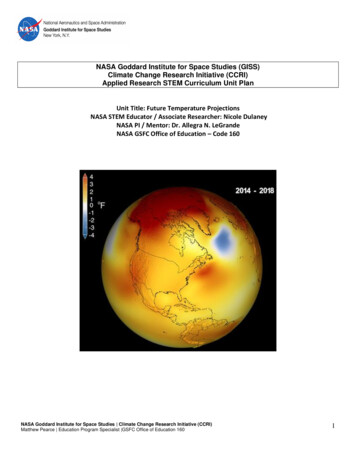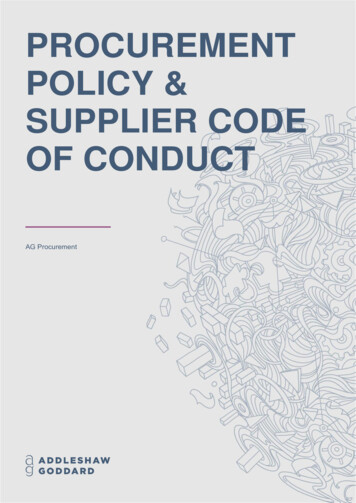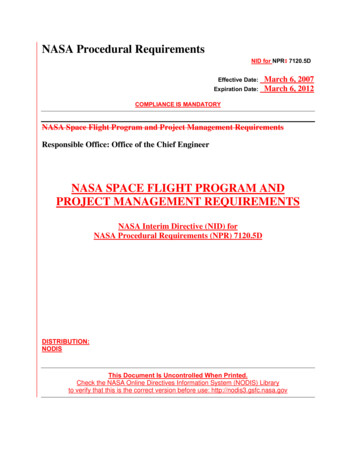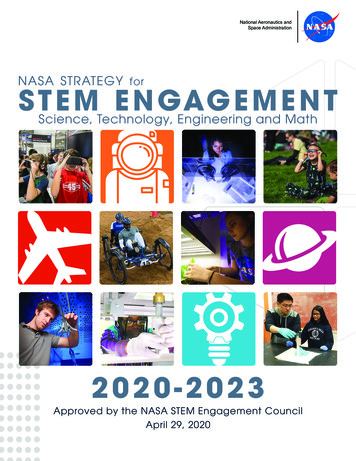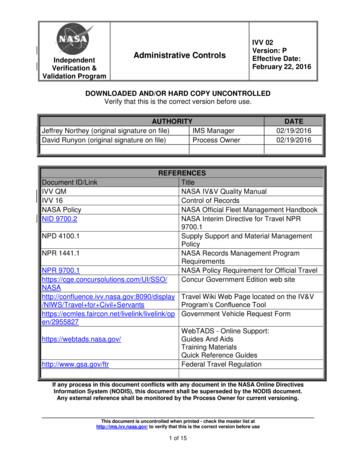
Transcription
Careers inScienceTechnologyEngineering &Mathematicswww.nasa.govWomen of GoddardNational Aeronautics and Space Administration
Women of GoddardNASA’s Goddard Space Flight CenterIV&V, WVGreenbelt, Maryland, Main CampusGoddardInstitute forSpace Studies,New York CityWallops Flight Facility, VirginiaTesting and Integration Facility, GreenbeltHome of Super Computing and Data Storage, GreenbeltGSFC’s new Sciences andExploration Building, GreenbeltWomen of Goddard: Careers in Science, Technology, Engineering, and MathematicsEditors: Claire L. Parkinson, Pamela S. Millar, and Michelle ThallerGraphics and Layout: Jay S. FriedlanderIn Association with:The Maryland Women’s Heritage Center (MWHC)NASA Goddard Space Flight Center, Greenbelt, Maryland, July 2011
Careers omen of GoddardA century ago women in the United States could be schoolteachers andnurses but were largely excluded from the vast majority of other jobs that couldbe classified as Science, Technology, Engineering, or Mathematics (STEM careers).Some inroads were fortuitously made during World Wars I and II, when because ofthe number of men engaged in fighting overseas it became essential that womenfill in on jobs of all types on the home front. However, many of these inroadswere lost after the wars ended and the men returned. As a result, in the 1950s and1960s, most women were still excluded from STEM careers other than teaching and nursing. The situation improvedmarkedly after passage in 1972 of Title IX, declaring that: “No person in the United States shall, on the basis of sex,be excluded from participation in, be denied the benefits of, or be subjected to discrimination under any educationprogram or activity receiving Federal financial assistance.”But laws alone cannot eliminate prejudicial attitudes or fully correct long-standing injustices. Although legallythere were no restrictions on the STEM careers women might enter, there remained many practical limitations,including girls growing up with a severe lack of women role models in STEM careers and often being told eitherexplicitly or implicitly that science, engineering, and mathematics are subjects and careers for boys and not girls.The women featured in this book are, for the most part, well aware that the jobs they have would not havebeen readily open to the women of previous generations. Many of these women are old enough to have had toovercome severe prejudices while growing up and early in their careers, and many helped to pioneer the way as thefirst female accomplishing one task or another. It is true that some of the women in this book still continue to findthemselves the only female in the room as important decisions are being made, but this has become less and lessfrequent, to the benefit of all.Partly because of the history of women in STEM careers, almost all the women in this book - whether theypersonally had to endure prejudice or not – are tremendously appreciative of the jobs they have. They have workedhard to perform well, and this has been reflected in the many recognitions and awards they have received. Not onlyhave most received Goddard and NASA awards, but quite a few have also been honored with major awards fromoutside of NASA. As examples: some have received honorary doctorates; some have Lifetime Achievement Awards;two (one now deceased) have been elected to the U.S. National Academy of Engineering; and several have beenelected Fellows of major national or international societies, including the American Association for the Advancementof Science (AAAS), the American Astronautical Society, the American Geophysical Union, and the AmericanMeteorological Society. Many have the satisfaction of having published articles about their research in professionaljournals, and some have also published books. Most have college degrees, and quite a few, especially in the sciencecategory, have Ph.D. degrees.Not only are the women in this book thriving in STEM careers, but we are doing so at a very unique andvery special place - NASA’s Goddard Space Flight Center (abbreviated NASA GSFC, or, more informally, NASAGoddard). Here we are part of the grand enterprise that is the American space program. As such, we are part of theagency that landed humans on the Moon, that sent robotic rovers to wander around on Mars, that has opened wholenew vistas on the universe through such missions as the Cosmic Background Explorer (COBE) and the HubbleSpace Telescope, and that has vastly increased the understanding of our home planet Earth through space-basedobservations from such satellite platforms as the Nimbus series, Landsat, and the satellites of the Earth ObservingSystem. We have taken major roles in many of those accomplishments and are heavily involved in the planning fornew missions that will further expand the exploration and understanding of the Earth and the universe. As partof the NASA family, we have shared in the amazing accomplishments of this amazing agency and have mournedtogether the great tragedies that have come on occasion during the efforts to accomplish incredibly difficult andsometimes extremely dangerous tasks.1
Women of GoddardWomen of GoddardAlthough this book features women from only one institution, it reflects the large variety of STEM careers nowopen to both women and men. It illustrates that people with solid STEM backgrounds can become not only scientistsand engineers of many types, technologists, and mathematicians, but also architects, computer programmers andvisualizers, patent attorneys, astronauts, managers, and other exciting possibilities. We hope especially that girls andboys reading this book will get excited by the variety of careers that will be open to them if they ground themselveswith the appropriate educational background in STEM subject matter.Fortunately, girls now are not growing up with many of the disadvantages of the past. In fact, boys are nowjust as likely to grow up with disadvantages of one type or another. Although this book only features women, it isimportant to recognize that the STEM careers illustrated are open to all – women and men, young and old and inbetween, any race, any ethnicity, and physically disabled or not. We hope that boys and girls will be equally inspiredby the numerous and varied careers highlighted herein.The idea for this book came about during a meeting in January 2011, when a group of Goddard womenscientists and engineers met with Linda Shevitz and Mary Cleave of the Maryland Women’s Heritage Center (MWHC)to brainstorm about ways in which Goddard women could participate in an exhibit under development at the MWHCcelebrating Maryland women in STEM careers. As a former NASA and Goddard employee – featured later in thisbook – Mary was the key link, initiating the contact between the MWHC and Goddard. After the decision was madeto produce the book, all Goddard women in STEM-related careers were encouraged to participate by providing onephotograph, text regarding their careers, and a quote, for a one-page highlight. We were extremely pleased that 101Goddard women responded (we additionally wrote entries for two prominent but deceased Goddard women) andthat those responses came from an exciting diversity of individuals. Ages represented range from teenagers throughsenior citizens; career states range from interns through retired long-time career employees; and many ethnicities andbackgrounds are represented, along with a wide variety of career choices. After editing to increase the consistency ofthe style and contents, these entries are compiled here in alphabetical order. Color coding has been used to distinguishcareers in science (blue), technology (green), engineering (gold), and mathematics (red), with the realization that insome cases more than one category could have been selected. For instance, computer scientists engage in activitiesrelated to each of the STEM categories, but we chose to place computer scientists under ‘mathematics’, as generallythe most appropriate of the four choices.Goddard management has been wonderfully supportive of this booklet, and we particularly thank CenterDirector Robert Strain, Sciences and Exploration Directorate Director Nicholas White, the Earth Observing SystemSenior Project Scientist Steve Platnick, the Women’s Advisory Committee, and the Diversity Council. We also verymuch thank Jay Friedlander, who did the final layout for the book and worked closely with us throughout thepublication process, and Diana Khachadourian, for help with copyediting.This has been an inspiring project to work on, as through this activity we have each learned more about thevaried and exciting careers of the women at Goddard. We hope that the readers will also be inspired and that thosethinking about future career choices will have their minds opened by the careers illustrated here.Claire L. Parkinson, Pamela S. Millar, and Michelle ThallerNASA Goddard Space Flight CenterGreenbelt, MarylandJuly 20112
Georgette Alexander-Morrison4Adriana Apolito-Bevis5Lisa Bartusek6Katherine Bender7Susan Breon8Pam Brinckerhoff9Beth Brown 10Kris Brown 11Molly E. Brown12Darlene Brummell13Lisa Callahan 14Ann Hornschemeier Cardiff15Candace Carlisle 16Nancy Carosso 17Lynn Carter 18Sandra Cauffman 19Rachael Celestine 20Katie Chakola 21Nona Minnifield Cheeks22Ruth W. Cholvibul23Jenny Chu 24Mary Cleave 25Yaireska M. Collado-Vega26Carmel Conaty 27Martha Dawsey 28Georgia A. de Nolfo29Shirley Dion 30Anne Douglass 31Darilyn M. Dunkerley32Kelly E. Fast33Sharon Marie Garrison34Holly Gilbert 35Heather Goo 36Karen Halterman 37Chanté Hill 38N. Christina Hsu39Gail Skofronick Jackson40Telana Jackson41Christyl Johnson42Felicia Jones43Sarah Jones44Angelita Castro Kelly45Caroline Kilbourne46Anne Kinney47Lora Koenig48Anne Koslosky49Barbara Lambert50Nancy Laubenthal51Jacqueline Le Moigne52Mackenzie Lowrance53Maureen Madden54Kathy Malnick55Nancy MaynardLisa MazzucaChelsea McDonaldJan McGarryLeva McIntireJaylee M. MeadMegan MeehanKatherine MelocikNargess MemarsadeghiPamela MillarSusan D. MorrisonAimee NeeleyCarey NollMaria NowakLola M. OlsenPeggy E. O’NeillMelanie N. OttClaire L. ParkinsonLori PerkinsWanda PetersSusanna PetroBarbara PfarrJeannette PlanteChanda Prescod-WeinsteinDiane PugelLorraine RemerJane RigbyNancy Grace RomanBarbara L. ScottHeather ShinnAmy Simon-MillerJoanne SimpsonMaria M. SoTeresa SpagnuoloCindy StarrAmber StraughnLili SunJean SwankFlorence TanMichelle ThallerSabrina ThompsonAnnie TsaoNzinga Temple TullNicholeen ViallJanelle VorreiterWei Li WangVictoria WeeksDeirdre WendelJennifer WisemanEve WooldridgeDorothy J. ZukorAppendix: 101102103104105106107Women of GoddardTable of Contents3
Women of GoddardGEORGETTE ALEXANDER-MORRISONBusiness Development Director(Contractor with Orbital Sciences Corporation)Georgette Alexander-Morrison began her aerospacecareer as a materials engineer working productionprocess evaluations, improvements, and failure analyses(electronics, adhesives, and coatings). Georgette’scareer transitioned into project management, where shemanaged flight and non-flight hardware development,production, and test activities. Her assignments includeda high gain antenna system, electronics assemblies, solararray substrates, cable assemblies (harnesses), and aSmall Explorer spacecraft structure fabrication. In oneassignment, Georgette spent two years on-site at NASAGoddard providing support for two NASA PolarOperational Environmental Satellite instruments: theHigh resolution Infrared Radiation Sounder (HIRS) and the AdvancedVery High Resolution Radiometer (AVHRR). Georgette served asOrbital’s Engineering Directorate Instrument Support Service contractProgram Manager for two years; after that, she transitioned intoBusiness Development. Georgette is currently a Director of BusinessDevelopment, managing the Orbital Technical Service Division’s inhouse proposals and working on new business capture management.Georgette is an active member of the St. George GreekOrthodox Church in Bethesda, Maryland; she teaches second gradeSunday school and works many hours at the annual Greek Festival. Forthe past four years, Georgette has volunteered with the ChesapeakeYouth Symphony Orchestra in Annapolis, Maryland, as a co-managerof the Concert Orchestra and the Symphony Orchestra. She loves toread mysteries and enjoys books by Clancy, Koontz, Deaver, Cornwell,Patterson, Reichs, Robb (Roberts), and Grafton. She is a ‘novice’ foodieand loves to cook Greek and Mediterranean foods. However, afterreading and watching Julie and Julia, Georgette has a new challenge—tocook “some” of the recipes in Julia Child’s Mastering the Art of FrenchCooking cookbook—the beef bourguignon is wonderful!Georgette beside a poster for a winning Orbitalproposal, March 2011. She had directed thesuccessful proposal production.“Make a decision. Get the work done. Live with the consequences and results of your decision.”4
ADRIANA APOLITO-BEVISProgram Manager(Contractor with Orbital Sciences Corporation)Adriana Apolito-Bevis began her Aerospacecareer in 1991 as a systems engineer developingand integrating secondary payloads ontothe Space Shuttle. She worked on the GetAway Special (GAS) and Hitchhiker (HH)programs at Goddard that were developedto utilize any remaining space on Shuttlemissions not used by the primary payloads.In 1997, she transitioned into a new role as aMission Manager for the Pegasus and Taurusprograms—small expendable launch vehiclesdeveloped by Orbital. As a mission manager,she helped launched many payloads for NASAincluding Terriers, the Solar Radiation and Climate Experiment(SORCE), the Galaxy Evolution Explorer (GALEX), and theAeronomy of Ice in the Mesosphere (AIM) satellite mission. Next,her career took her into the commercial arena, where she led theSpacecraft Integration department at International Launch Services(ILS). While at ILS, she launched many commercial payloads forsatellite providers around the world on the Russian Proton launchvehicle. After several years of travelling to exciting places such asToulouse, Tunisia, Paris, Moscow, and the Baikonur Cosmodromein Kazakhstan, her career brought her back to Orbital SciencesCorporation. Adriana is working in the Technical Services Divisionas a Program Manager for Goddard’s Software Engineering Servicesand Space Communications and Network Services contracts. Shealso works on new business capture management.Adriana currently volunteers as a member of the City DockAdvisory Committee for the City of Annapolis. This committee ischartered with spearheading the City’s planning effort to redevelopCity Dock and will present a City Dock plan to Mayor Josh Cohenand the City Council. The City Dock plan will establish the guidingprinciples for City Dock and set the stage for design planning.Adriana beside the proposal cover of a winning Orbital contract with NASA Goddard,March 2011. She was a vital member of thewinning proposal team.“Always strive to make improvements in everything you do. There are always opportunities to grow in knowledgeand ability. It is important to take advantage of every chance to learn more about ourselves and the changingworld. Always remain open to new ideas and directions.”Science Technology Engineering Mathematics5
Women of GoddardPhoto by Warren ShultzabergerLISA BARTUSEKSystems Engineer(NASA GSFC civil servant)Lisa Bartusek started her career atGoddard fresh out of school witha bachelor’s degree in ElectricalEngineering. She has had the privilege ofbeing part of the development team forseveral in-house scientific Observatorydevelopments, with missions rangingfrom investigating the beginning ofthe Universe to studying the Sun. Lisacurrently works as a Systems Engineerfor the Global Precipitation Measurement (GPM) Observatory,which is a partnership between NASA and the Japanese AerospaceExploration Agency (JAXA). The GPM mission will advance theunderstanding of the Earth’s water and energy cycles and will extendcurrent capabilities in using accurate and timely information onprecipitation to directly benefit society. Lisa works at the Systemlevel to ensure the technical integration and verification of thevarious pieces of the Observatory, including spacecraft electronicsbuilt in-house at Goddard and precipitation radars built in Japan.Lisa outside the cleanroom at Goddardin which the GPM spacecraft is beingintegrated, April 2011.“The most important skill to have for this job is the ability to listen to all the opinionsand sort out the best technical solution given the schedule, cost, and risk constraints.It’s a challenge every day and I love it!”6
KATHERINE BENDEREducation Specialist(Contractor with ARES Corporation)Connecting NASA science and engineering content directlyto the classroom has taken Katherine Bender all the wayfrom the lowest spot in the Western Hemisphere to oneof the most active volcanoes on Earth, and from inside acleanroom where the Aqua and Aura satellites were beingbuilt to above the clouds on top of Mauna Kea; and herstudents and classrooms across the country have gone withher both physically and virtually. Having started her careerwith a science background plus 19 years teaching scienceat the secondary level, Katherine’s work at Goddard beganwith developing a curriculum for a remote sensing programand producing educational webcasts spotlighting the Aquaand Aura Earth-observing missions. Now she serves asan Education Specialist in the Goddard Education Office,where her passion for engaging teachers and students with soundscience content and her experience with scientific processes andtechnology integration are exercised through her project managementof the History of Winter professional development program and hercoordination of the Goddard High School Internship programs.Katherine perched at Artist’s Palette,Death Valley, California, site of aremote webcast, December 2000.“I have always loved science, especially the never-ending nature of study. Something that I’ve shared with mystudents and, in fact, with my own children, is a quote that I first heard from a coach: ‘When you’re throughlearning, you’re through.’ It has become the foundation of my education philosophy and keeps me focused onknowing what I can and do know, and even better, what I don’t know. I enjoy it too much to ever want to quit!”Science Technology Engineering Mathematics7
Women of GoddardPhoto by Jay FriedlanderSUSAN BREONCryogenics Engineer(NASA GSFC civil servant)As Head of the Cryogenics and Fluids Branchat NASA Goddard, Susan Breon manages25 physicists, engineers, and technicians tobuild cold—really cold—systems to cooldetectors and optical systems to temperaturesnear absolute zero. The cryogenic systemsthat her branch builds operate from a hightemperature of about 100 Kelvin (-280 F) to as low as 50milliKelvin (-459.6 F). At these temperatures, the detectors onsatellites can see the faintest of signals from the earliest galaxiesand can pick up individual X-rays from around black holes andcolliding galaxies. For satellites looking towards Earth, cryogenicdetectors are used to track hot spots like volcanoes and forestfires, as well as cool spots like underground water and vegetation.As part of her work, Susan has travelled to many places aroundthe globe, including exciting locales such as Japan, Switzerland,and Alaska. She is very proud of the work she did in developingthe Helium Insert for the X-ray Spectrometer, an instrumentaboard the Japanese Astro-E satellite. The system included a liquidhelium system at 1.3 Kelvin and a special type of refrigeratorknown as an adiabatic demagnetization refrigerator operating at60 milliKelvin.Susan next to the Astro H test dewarat NASA Goddard, April 2011.“It is a privilege to work on such exciting missions and with such great teams as we have at NASA.”8
PAM BRINCKERHOFFThermal Engineer(Contractor withEdge Space Systems)Pam Brinckerhoff becameinterested in space systemsengineering after taking anastronomy class in high school.The class assigned each studenta picture taken from the HubbleSpace Telescope to examine;and Pam was amazed by theimages and impressed thatspacecraft were needed to see such cool things in space. Theidea of working on spacecraft as her career was very exciting,so she pursued aerospace engineering in college. Pam became athermal engineer after an internship introduced her to the field,where she found that she really enjoyed working on the thermaldesign of spacecraft because of the challenge to keep differentparts of the spacecraft at the right temperatures in the extremespace environment.Pam has worked as a thermal engineer at Goddard since2010. As an early career engineer, she has had the opportunityto work on a cryogenic instrument called TIRS, which standsfor Thermal InfraRed Sensor and will collect thermal imagesof the Earth. While working on TIRS, Pam designed, analyzed,and conducted several tests on the radiators to ensure that theyfunctioned as expected, and she is currently working on thedesign of the thermal blankets for the instrument. Pam dividesher time at work between preparing for her next integration taskand working in a cleanroom on the flight hardware.Pam in front of the Thermal InfraRedSensor (TIRS) radiators, February 2011.“I really feel like the work I’m doing is important. The data produced by TIRS will help better manage the waterbudget across the country, which can help us reduce our carbon footprint. It’s really cool to think that I’m working onsomething that is going to have an impact like that.”Science Technology Engineering Mathematics9
Women of GoddardPhoto by Jay FriedlanderBETH BROWNAstrophysicist(NASA GSFC civil servant, deceased)Beth Brown was always fascinated by space.She grew up watching Star Trek and Star Wars,wanting to become an astronaut. However, thatinitial goal was hindered by nearsightedness,and so she turned her interest to the study ofthe stars, and after receiving her Ph.D. cameto NASA Goddard as a National Academy ofScience/National Research Council (NAS/NRC)Post-Doctoral Research Associate. In 2001, shewas appointed as an Astrophysicist Fellow inthe NASA Administrator’s fellowship Program(NAFP) and was named a Visiting Assistant Professor atHoward University. Her most recent position was AssistantDirector for Science Communications and Higher Educationin the Science and Exploration Directorate at NASA Goddardbefore her tragic death at age 39 on October 5, 2008.Beth Brown was a rising star in the field of astrophysics.She lit up a room with her smile and made everyone in herpresence feel that they were important. After her death, theWomen in Astronomy and Space Science Conference 2009 wasdedicated to her memory and to her contributions not just in thefield of astronomy but also in inspiring women and minoritiesto pursue careers in astrophysics.Beth doing outreach at theGoddard visitor center.“It is a privilege to work on such exciting missions and with such great teams as we have atNASA.”10
Photo by Bill HrybykKRIS BROWNSystems Engineer and Strategist(NASA GSFC civil servant)In her 22 years at NASA, Kris Brown has contributedto a wide and diverse range of endeavors, all leading toan exciting and fulfilling career. Early on, Kris learnedfirsthand through hands-on work and was accountablefor the assembly and testing of instruments andspacecraft. As the Mechanical Systems Manager onthe Global Geospace Science Wind and Polar and theTracking and Data Relay Satellite (TDRS) missions, sheworked in close collaboration with other discipline andsystems engineers. On Wind and Polar, Kris workedwith 22 science teams simultaneously to accommodateinstruments that later performed valuable measurementsof the magnetosphere. TDRS provided a unique opportunity tomanage multiple spacecraft at various phases of development— spacecraft assembly, test, and launch preparation andoperations for TDRS-F and TDRS-G on STS-54 and STS70. She also led the creation of the Integrated MissionDesign Center (IMDC), literally transforming how Goddardapproached the early design of missions and instruments, andused her skills in strategy and planning in helping to developNASA’s response to the Columbia Accident InvestigationBoard report and in leading the development of Goddard’sStrategic Plan in 2008. In 2010, Kris followed her passion inengaging and educating students and the public, taking on theexciting assignment of Deputy Chief of Goddard’s Office ofCommunications.Kris in her official NASA photo,November 2010.“NASA has provided me with tremendous opportunities – and multiple paths to explore and contribute. In mycurrent position, I am able to translate my experiences as an engineer and communicate Goddard’s amazingwork in a real and exciting way. I have aligned my passion for engaging and educating students and the publicin science, engineering, and technology with what I do every day, making tangible contributions to our nation’sscience literacy.”Science Technology Engineering Mathematics11
Women of GoddardMOLLY E. BROWNGeographer(NASA GSFC civil servant)Molly Brown uses satellite data to study agricultureand food security in developing countries, as wellas in a broad array of applications of remotesensing data, such as monitoring floods in Nepaland urban tree growth in the Eastern UnitedStates. She is involved in a range of projects thatfocus on expanding the use and utility of satellite remote sensingobservations and Earth science models in a variety of decisionmaking contexts.Molly has worked on integrating satellite remote sensinginformation into econometric models that promise to predictvariations in local food prices during extremely wet and dryevents in West Africa. She also works with the U.S. Agency forInternational Development’s Famine Early Warning SystemsNetwork (FEWS NET). In this role she provides information andexpertise on satellite-derived global vegetation data (particularlyfrom NOAA Advanced Very High Resolution Radiometerinstruments, hence her work with NOAA-N Prime) and on usingdata from multiple sensors in work identifying and documentingfood security crises. Her work with FEWS NET has been the basisof a broader investigation of how Earth science data are used fordecision making in a variety of settings, including those of (1)deciding how melting glaciers will affect millions of people in Asiawho are dependent on river water and (2) understanding the effectof weather on food production globally. She is currently workingwith NASA’s Soil Moisture Active Passive (SMAP) mission and ison the Science Definition Team of NASA’s Carbon MonitoringSystem (CMS).Molly live on network television discussingthe launch of NOAA-N Prime, from theNASA Goddard television studio, February2009.“As a NASA civil servant, I have the opportunity to be involved in developing and launching satellites that willprovide data in the coming decades that can answer key questions regarding how the environment is changing. Inever dreamed that I would have such great opportunities so early in my career – leading large groups of extremelysmart people is both fun and challenging!”12
DARLENE BRUMMELLArchitect(NASA GSFC civil servant)Darlene Brummell is anArchitect, Project Manager,andBuildingOutfittingTeam Lead in the FacilitiesManagement Division atGoddard. Darlene has beenemployed with NASA forover 25 years and began herarchitectural career as a co-opstudent at Goddard’s WallopsFlight Facility in WallopsIsland, Virginia.As Outfitting Deputy Project Manager for the newExploration Sciences Building (ESB), Darlene led and advised in theplanning, organizing, and directing of the largest building outfittingeffort at Goddard. The ESB is a state-of-the-art facility designed toU.S. Green Building Council Leadership Energy and EnvironmentalDesign (USGBC LEED) Gold rated standard. The facility is 200,000square feet and houses various space-usage types, such as offices forcenter level directorate, divisions, and branch management, scientistand engineers, and multiple laboratory facilities. The ESB houses atotal of 39 labs and five cleanrooms, including a MicrocalorimeterCleanroom, Ultraviolet Detector Lab, Flight Electronics Lab,four Science Mission Operations Rooms, Mission Operations andArchives Room for the Composite Infrared Spectrometer on theCassini mission, the Lunar Exploration Neutron Detector ScienceOperations Center Room, and a Mechanical Design and PrototypeRoom. The ESB also provides space for our in-house externalpartners such as the Emeriti Room and Post Doctoral Rooms, aswell as a contemporary open space area for the interns and summerstudents.Darlene across the street fromthe Goddard Child DevelopmentCenter, April 2011.“My desire to work for NASA started with my passion for the TV series Star Trek. It’s so cool to be involved withthe science and technology that defines our lives now as well as in the future, so ‘Live long and prosper’.”Science Technology Engineering Mathematics13
Women of GoddardLISA CALLAHANAerospace EngineerPhoto by Ryan Cargo(NASA GSFC civil servant)While working at NASA for almost 23 years, LisaCallahan has designed, analyzed, and tested propulsionsystems, negotiated international agreements for theSpace Station, and managed Goddard’s technologydevelopment program. Starting at Goddard as apropulsion engineer, Lisa went on to get a Master’sdegree in Science, Technology, and Public Policy that led toworking at NASA Headquarters for 6 years before returningto Goddard. Lisa currently serves as the Associate Director forMission Planning and Technology Development in the EarthSciences Division, a position that brings together scientists,instrument and systems engineers, and mission planners todevelop new measurement concepts.Lisa helping to prepare the Multiple Altimeter
Lynn Carter 18 Sandra Cauffman 19 Rachael Celestine 20 Katie Chakola 21 Nona Minnifield Cheeks 22 Ruth W. Cholvibul 23 Jenny Chu 24 Mary Cleave 25 Yaireska M. Collado-Vega 26 Carmel Conaty 27 Martha Dawsey 28 Georgia A. de Nolfo 29 Shirley Dion 30
